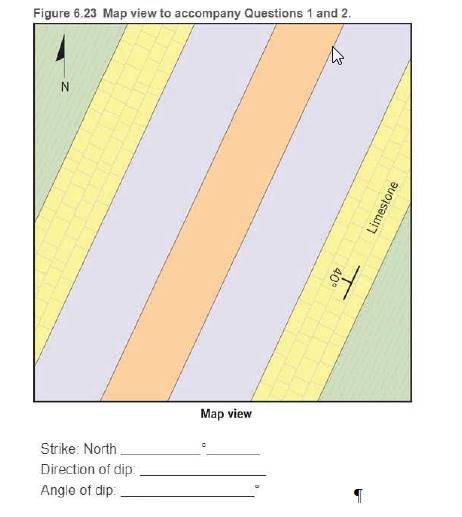
Refer to Figure 6.23 to describe the strike and dip of the limestone layer

Introduction:
The sedimentary rocks are formed from sediments that are transported by running water to the shallow seas, and over time they undergo processes like compression, compaction, burial, and cementation in the deep crust to form sedimentary rocks.
Answer to Problem 1LR
Correct answer:
The strike in the given limestone layer is 25 ° East. The direction of dip is 180 °, and the angle of dip is 40°.
Explanation of Solution
The method of calculating the strike, angle of dip, and direction of dip includes the measurement of strike and dip present on the rock layers or planar features. The strike in limestone is defined as the compass direction that is relative to north. It is constructed of the line formed by the intersection of a rock layer. The strike of the limestone layer is 25 ° East, the direction of dip is 180 °, and the angle of dip is 40°.
Want to see more full solutions like this?
Chapter 6 Solutions
Applications and Investigations in Earth Science (9th Edition)
Additional Science Textbook Solutions
Campbell Biology: Concepts & Connections (9th Edition)
Physics for Scientists and Engineers: A Strategic Approach, Vol. 1 (Chs 1-21) (4th Edition)
Brock Biology of Microorganisms (15th Edition)
Campbell Biology (11th Edition)
Chemistry: An Introduction to General, Organic, and Biological Chemistry (13th Edition)
Human Biology: Concepts and Current Issues (8th Edition)
- How is land use related to water quality and quantity? What are local examples in Connecticut?arrow_forwardWhat are the similarities between domestic and industrial water use? How are they different from in-stream use?arrow_forwardDo you believe that large-scale hydroelectric power plants should be promoted as a renewable alternative to power plants that burn fossil fuels? What criteria do you use for this decision?arrow_forward
- Do nonfarmers have an interest in how water is used for irrigation? Under what conditions should the general public be involved in making these decisions along with the farmers who are directly involved?arrow_forwardLeakage from freshwater distribution systems accounts for significant losses. Is water so valuable that governments should require systems that minimize leakage to preserve the resource? Under what conditions would you change your evaluation?arrow_forwardwhat are the three main classifications of rock that make up the earth’s crust? please describe the distinguishing features of these three types of rockarrow_forward
- Please describe a scenario that could lead to more water being stored on the continents at the expense of water stored in the oceanarrow_forward1. Complete the block diagram in Figure 6.20 by drawing a left-lateral fault on Part B. 2. Draw arrows on both sides of the fault in Figure 6.20B to illustrate the relative motion of each block.arrow_forwardOn each of the block diagrams in Figure 6.16, determine the relative ages of the surface rocks on both sides of the fault trace (after erosion) and write the word older or younger on the appropriate side of each fault trace.arrow_forward
 Applications and Investigations in Earth Science ...Earth ScienceISBN:9780134746241Author:Edward J. Tarbuck, Frederick K. Lutgens, Dennis G. TasaPublisher:PEARSON
Applications and Investigations in Earth Science ...Earth ScienceISBN:9780134746241Author:Edward J. Tarbuck, Frederick K. Lutgens, Dennis G. TasaPublisher:PEARSON Exercises for Weather & Climate (9th Edition)Earth ScienceISBN:9780134041360Author:Greg CarbonePublisher:PEARSON
Exercises for Weather & Climate (9th Edition)Earth ScienceISBN:9780134041360Author:Greg CarbonePublisher:PEARSON Environmental ScienceEarth ScienceISBN:9781260153125Author:William P Cunningham Prof., Mary Ann Cunningham ProfessorPublisher:McGraw-Hill Education
Environmental ScienceEarth ScienceISBN:9781260153125Author:William P Cunningham Prof., Mary Ann Cunningham ProfessorPublisher:McGraw-Hill Education Earth Science (15th Edition)Earth ScienceISBN:9780134543536Author:Edward J. Tarbuck, Frederick K. Lutgens, Dennis G. TasaPublisher:PEARSON
Earth Science (15th Edition)Earth ScienceISBN:9780134543536Author:Edward J. Tarbuck, Frederick K. Lutgens, Dennis G. TasaPublisher:PEARSON Environmental Science (MindTap Course List)Earth ScienceISBN:9781337569613Author:G. Tyler Miller, Scott SpoolmanPublisher:Cengage Learning
Environmental Science (MindTap Course List)Earth ScienceISBN:9781337569613Author:G. Tyler Miller, Scott SpoolmanPublisher:Cengage Learning Physical GeologyEarth ScienceISBN:9781259916823Author:Plummer, Charles C., CARLSON, Diane H., Hammersley, LisaPublisher:Mcgraw-hill Education,
Physical GeologyEarth ScienceISBN:9781259916823Author:Plummer, Charles C., CARLSON, Diane H., Hammersley, LisaPublisher:Mcgraw-hill Education,





